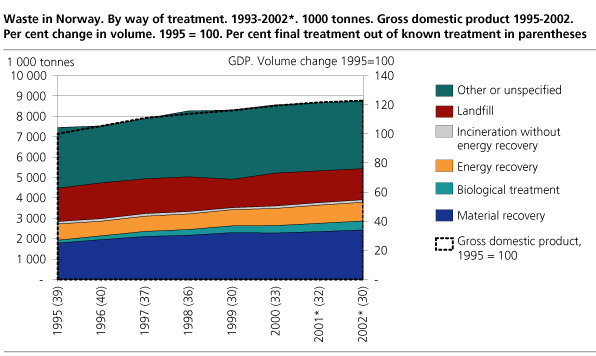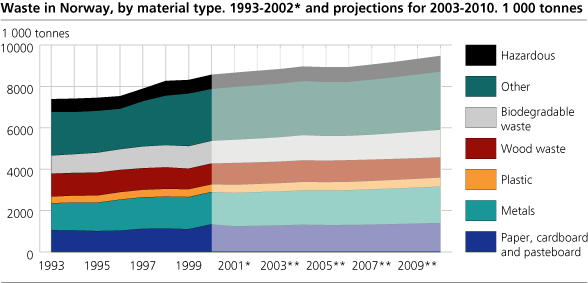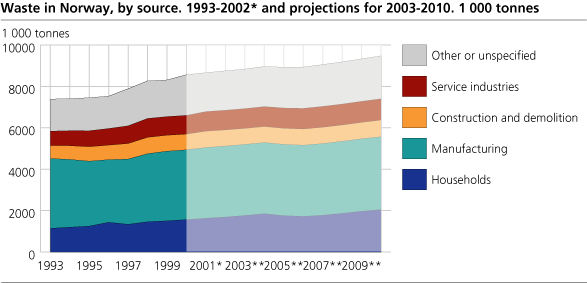Content
Published:
This is an archived release.
Slight increase in waste amounts
8.7 million tonnes of waste arose in Norway in 2002. About 3.8 million tonnes were recovered.
According to preliminary calculations, almost 8,7 million tonnes of waste arose in Norway in 2002, which is 2.2 per cent more than in 2000. About 70 per cent of the waste for which we know the way of treatment, was recovered in 2002. This is three percentage points more than in 2000 and nine more than in 1995.
Of the different kinds of recovery, biological treatment (mainly composting) has had the fastest growth up to 2002, from 364 000 tonnes to 439 000 tonnes. About 300 000 tonnes less waste was landfilled in 2002 than in 2000. About 2.5 million tonnes of waste had unknown or unspecified treatment in 2000. Hazardous waste is excluded in the calculation of recovery percentage.
More and more household waste
Of the different sources of origin, private households are the one, which has shown the fastest growth throughout the 1990-ies. Norwegian households generated 1.7 million tonnes of waste. This is slightly more than previously published figures showed (read more: Household waste, 2002 ), because the waste accounts include some more product types than the household waste statistics, e.g. scrapped cars. Service industries and manufacturing seems to have generated respectively five and two per cent more waste in 2002 than in 2000, or 0.95 and 3.43 million tonnes respectively in 2002.
Small changes in material composition
There has been little change in the material composition of the waste. According to the preliminary figures, the most abundant materials in 2002 were metals (19 per cent), paper (14 per cent), biodegradables (13 per cent) and wood (12 per cent). The amount of hazardous waste rose to 694 000 tonnes in 2002.
See Waste accounts for Norway, 1993-2000 for more details about the years up to 2000.
Projections for 2003-2010
The same calculations project a further growth in total waste amounts by eight per cent from 2002 to 2010 to reach nearly 9,5 million tonnes. A goal for the environmental policy in Norway is that waste generation shall increase less than the economic growth measured by gross domestic product. The preliminary figures and projections indicate that this is the case today and will be so in the near future also.
Preliminary figures and projections are worked out with the same methodology, based on the observed relationship between waste generation and production in the different industries. These relationships are then combined with Statistics Norway's prognoses for production in the different industries to give projected waste amounts. Projected or anticipated political, legal or social changes, which may alter the relationship between production and waste generation, are not taken into account in the projections.
Tables:
Contact
-
Camilla Skjerpen
E-mail: camilla.skjerpen@ssb.no
tel.: (+47) 48 22 72 14



